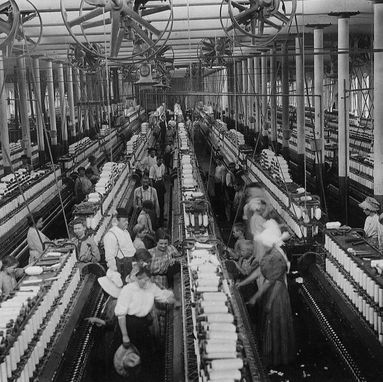One of the main industries that benefited from the Industrial Revolution was the textile industry. The textile industry was based on the development of cloth and clothing. Before the start of the Industrial Revolution, which began in the 1700s, the production of goods was done on a very small scale. Historians refer to this method of production as the ‘cottage industry’. Simply put, the cottage industry refers to a period of time in which goods for sale were produced on a very small scale, usually in a home. In this system, people produced goods, such as wool, in their homes or on their own farms and then sold it to local communities since long distance transportation was uncommon. This method of production was slow and inefficient and struggled to keep pace with the growing demand caused by the increased population. In contrast, industrialization allowed goods to be produced in a central location and on a mass scale. It also led to the creation of inventions that helped speed up the production method of many goods, but most noticeably in the textile industry.
Throughout the 1700s, inventors such as Richard Arkwright, Eli Whitney, James Hargreaves, John Kay and Edmund Cartwright, developed machines and techniques that helped improve production, especially in terms of the textile industry. For example, in 1733 John Kay developed a wheel shuttle, later known as a flying shuttle. The machine improved weaving efficiency and reduced labor needs because it could be operated with only one operator. James Hargreaves created the spinning jenny in 1764, which allowed a machine with many spindles of thread to be spun at one time. Richard Arkwright added to this by developing the water frame in 1769. The water frame allowed over one hundred spindles of thread to be spun at one time but was so large and needed so much energy that he built it next to rivers and creeks in order to use the force of the water to spin the machine. For his part, Edmund Cartwright developed the power loom in 1785 which allowed quicker production of cloth. Finally, American inventor, Eli Whitney developed the cotton gin in 1793, which allowed for quicker production of cotton. Previously, cotton had to be hand cleaned in order to remove fibers and seeds. Whitney’s cotton gin sped up this process and allowed for much faster harvesting of the resource. In all, these inventions mechanized the textile industry and led to the establishment of factories throughout Britain, which was the first country to industrialize.










